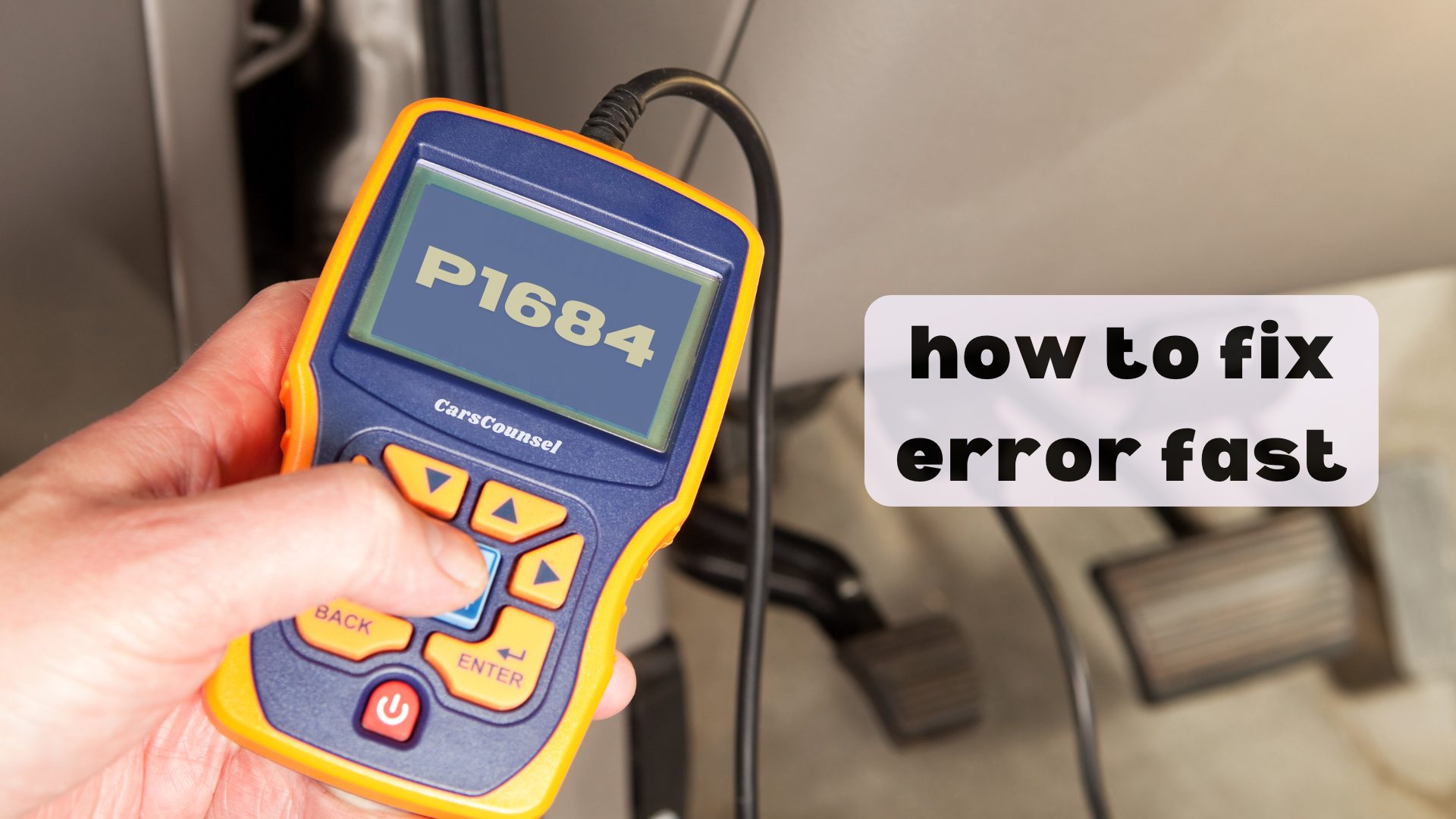Fixing the P1684 code might feel overwhelming, but you don’t need to be a pro mechanic to handle it.
First, use an OBD-II scanner to confirm the error and check for any other OBD2 codes.
Look at the battery terminals to see if they’re corroded or loose—this could be the problem. Cleaning or replacing the terminals and making sure they’re tight might solve the issue.
If that doesn’t work, test the battery voltage and see if the alternator needs to be checked out.

Quick Navigation
Key Takeaways
- Use an OBD-II scanner to confirm the P1684 code and check for other problems.
- Look at the battery terminals for any rust or looseness and clean or tighten them if needed.
- Use a multimeter to check the battery voltage; it should be around 12.6 volts.
- Inspect wiring harnesses and ground points for any damage or rust, and fix them if needed.
Understanding the P1684 Code
The P1684 code means your car’s battery was disconnected in the last 50 times you started the engine. This can cause electrical problems. To deal with this code, you should focus on keeping your battery in good shape and checking the electrical system.
Start by using an OBD-II scanner to verify the P1684 code. Then, look at your battery connections and wiring to see if there’s any rust or if they’re loose.
Check the battery voltage; it should be around 12.6 volts. If it’s lower, you might need a new battery. Also, make sure all ground points are clean and tight.
Regularly tightening connections and checking voltage can help prevent this code from coming back and keep your car’s electrical system working well.
Implications of the P1684 Code
Fixing the P1684 code is crucial because it affects how well your car runs and can lead to problems like transmission issues and failing emissions tests if ignored.
This code means there’s a significant electrical problem in your car. If the battery or its connections are bad, it can mess up the whole electrical system.
This can cause:
- Transmission Problems: Electrical issues can make your transmission act up.
- Failed Emissions Tests: An unstable electrical system might make your car fail emissions tests.
- Poor Engine Performance: Uneven electrical flow can lower your engine’s efficiency.
Common Causes of P1684
Common causes of the P1684 code include a recent battery disconnection, a weak or dead battery, corroded or loose connections, a faulty alternator, and blown fuses or damaged wiring.
It’s important to keep your battery in good shape. If you recently changed or disconnected the battery, the code might show up.
Weak or dead batteries can’t keep a steady voltage, which can trigger the error. Corroded or loose connections mess up the electrical flow, so you need to check them right away.
A bad alternator doesn’t charge the battery properly, causing power problems. Also, blown fuses or damaged wiring can break the circuit, leading to the P1684 code.
Regularly check and take care of your battery and electrical system to avoid these issues and keep your vehicle running smoothly.
Affected Vehicle Models
For cars like the Chrysler PT Cruiser, Dodge Neon, and Chrysler Stratus, the P1684 code often shows up because these vehicles are prone to electrical issues. These models tend to have problems with battery disconnection or weak connections, which can set off the code.
If you own one of these cars, you might face:
- Annoyance: The check engine light comes on a lot.
- Disruption: Your car might break down unexpectedly, messing up your plans.
- Expense: Fixing these issues repeatedly can get expensive.
Knowing that the Chrysler PT Cruiser and Dodge Neon are especially prone to these problems can help you stay on top of things.
Regularly check your battery connections and keep them clean to avoid some of these issues.
Don’t ignore the warning signs, and take steps to keep your car running smoothly.
Initial Diagnostic Steps
To start diagnosing the P1684 code, plug an OBD-II scanner into the car’s diagnostic port and check for any stored trouble codes.
Do an initial scan to confirm the P1684 code is present and see if there are any other codes that might point to related problems.
After you get the codes, take a look at the Engine Control Module (ECM).
Check for any updates or faults in the ECM, since a faulty ECM can cause the P1684 code.
Make sure to write down everything you find from the initial scan and the ECM check.
This step-by-step method ensures you catch all potential issues with the car’s electrical system before diving into more specific diagnostics.
Visual Inspection Tips
After you’ve confirmed the P1684 code with your OBD-II scanner and noted any other related codes, the next step is to do a thorough visual check of the battery and its parts.
First, look at the battery terminals to see if they’re corroded or loose. Corroded terminals can mess up electrical connections and trigger error codes.
Next, check the wiring harnesses connected to the battery and the ECM. Look for any wires that are frayed, damaged, or disconnected, as these can interrupt the power flow.
Lastly, make sure all the ground points are secure and free from corrosion. Poor grounding can cause various electrical problems.
Focus on these three key areas:
- Battery terminals
- Wiring harnesses
- Ground points
Voltage Testing Procedure
Checking your battery’s voltage is important to figure out what’s causing the P1684 code.
First, make sure the engine and all electrical devices are turned off.
Get a multimeter and set it to measure DC voltage. Attach the positive lead to the positive terminal of the battery and the negative lead to the negative terminal.
A good battery should read around 12.6 volts. If the reading is much lower, your battery might be in bad shape and could need replacing.
Make sure all connections are clean and tight for an accurate reading.
Regular voltage checks can help keep your battery in good condition and stop problems that cause the P1684 code.
Common Fixes for P1684
Addressing the P1684 code usually involves several common fixes that deal with battery disconnection problems.
Start by using diagnostic tools to confirm the code and find any other issues. Good battery maintenance is important to fix this error.
Here are three common fixes to consider:
- Battery Connections: Fix or replace corroded or loose battery terminals to ensure a stable electrical connection.
- Faulty Alternator: Replace the alternator if it’s not charging the battery properly, to prevent power interruptions.
- Wiring and Fuses: Fix any damaged wiring and replace blown fuses to restore proper electrical flow.
Preventive Measures
To keep your car’s electrical system in good shape and avoid the P1684 code, follow these simple steps.
First, regularly check and clean your battery terminals to ensure a strong connection.
Inspect your car’s wiring and ground points for any signs of wear or corrosion.
Use a multimeter to check that your battery voltage is around 12.6 volts.
Make sure to keep your car’s software and ECM firmware updated to prevent any issues.
Also, schedule regular professional inspections to catch any potential problems early.
Resources for Further Assistance
Resources for Further Help
If you’re dealing with the P1684 code and need more help, here are some great resources you can turn to:
- Online Forums: Join car forums where people share their experiences and solutions. Websites like Reddit and specialized car forums can be very useful.
- Automotive Websites: Check out trusted automotive websites for detailed articles, how-to guides, and repair instructions. Sites like AutoZone and RepairPal have lots of helpful information.
- Professional Mechanics: If things get too tricky, don’t hesitate to ask certified mechanics for help. They’ve the skills and tools to find problems that might be hard to diagnose on your own.
Using these resources will help you handle the P1684 code more effectively.
More OBD-II Codes
Frequently Asked Questions
Can a P1684 Code Cause the Transmission to Shift Improperly?
Yes, a P1684 code can affect how the transmission shifts. It’s important to do a detailed check, including looking at battery connections and voltage, to make sure the transmission works correctly and to fix any electrical problems.
Will a P1684 Code Affect My Vehicle’s Fuel Economy?
Curious if a P1684 code will affect your fuel economy? Yes, it can. Bad battery connections and faulty sensors might make your engine work harder. Use diagnostic tools to find the problems and get your car running smoothly again.
How Can I Identify if My Alternator Is Causing the P1684 Code?
To find out if your alternator is causing the P1684 code, check the alternator. Start the engine and use a voltmeter to measure the voltage at the battery terminals. It should be between 13.5 and 14.5 volts. If the readings are lower, you might need to replace the alternator.
Is It Safe to Drive With the P1684 Code Active?
Driving with the P1684 code active can be risky. This code may indicate electrical problems and poor engine performance, which can affect your safety on the road. It’s a good idea to fix the issue as soon as possible to ensure safe driving.
How Often Should I Check My Vehicle’s Battery Connections to Prevent P1684?
You should check your vehicle’s battery connections every three months. Regular checks make sure the connections are clean and tight, which helps prevent problems. Use a multimeter to keep an eye on voltage levels and maintain your electrical system.
Conclusion
To quickly fix the P1684 code, start by checking the battery terminals and voltage.
Did you know that almost half of all electrical problems in cars come from battery issues? Make sure the connections are clean and secure, and the battery is working properly.
Regular maintenance can help you avoid these problems in the future. If the issue persists, it might be a good idea to talk to a mechanic or look into professional resources for more help.
Staying on top of these things can keep your car running smoothly.

